MB&F Legacy Machine Thunderdome: The World‘s Fastest Triple-Axis Tourbillon – You Can’t Miss It! (Plus Videos)
Anyone interested in fast cars probably knows that there is a constant battle to hold the land speed record. Depending on what type of vehicle it is, what powers it, how many wheels it has, and whether driven by a man, woman, teenager, senior citizen, or some other differentiating characteristic, there is a record for it. Some records tend to hang around quite a while due to their uniqueness, but many are surpassed faster than you can blink (sometimes literally).
Being a record holder is to be in a state of impermanence, a constant flux that sees one rise to the top only to be overtaken soon after. The process is sort of like boiling water, with the cycle bringing the same contenders back to the top before peaking and going back to the drawing board to eke out another few miles per hour.
Discoveries are made, technology advances, a new record is set and the cycle continues. This is pretty much true wherever records are being set. Sometimes record setting slows down until the next technological breakthrough, which then sees a surge in attempts and new records.
Occasionally, records are broken by the same people who set them as they improve techniques and skillsets or fix small mistakes from previous record attempts. With land speed records money plays a large part and getting sponsors to foot the bill is key to holding on to a title – in fact that is true for nearly all major records across sport, auto sport, and technology-based endeavors.
But sometimes the person seeking a record needs iteration faster than the development afforded by a single backer. A perfect example of this comes from the watchmaking industry through the work of Eric Coudray.
This master watchmaker not only developed one of the early multi-axis tourbillons – Jaeger-LeCoultre’s 2004 Gyrotourbillon 1 – but in the last few years has been behind the fastest triple-axis tourbillon in the world not once, but three times.
Coudray’s latest entry into the record books is also the most surprising of the three as it was made by none other than MB&F. And it contains a few world firsts.
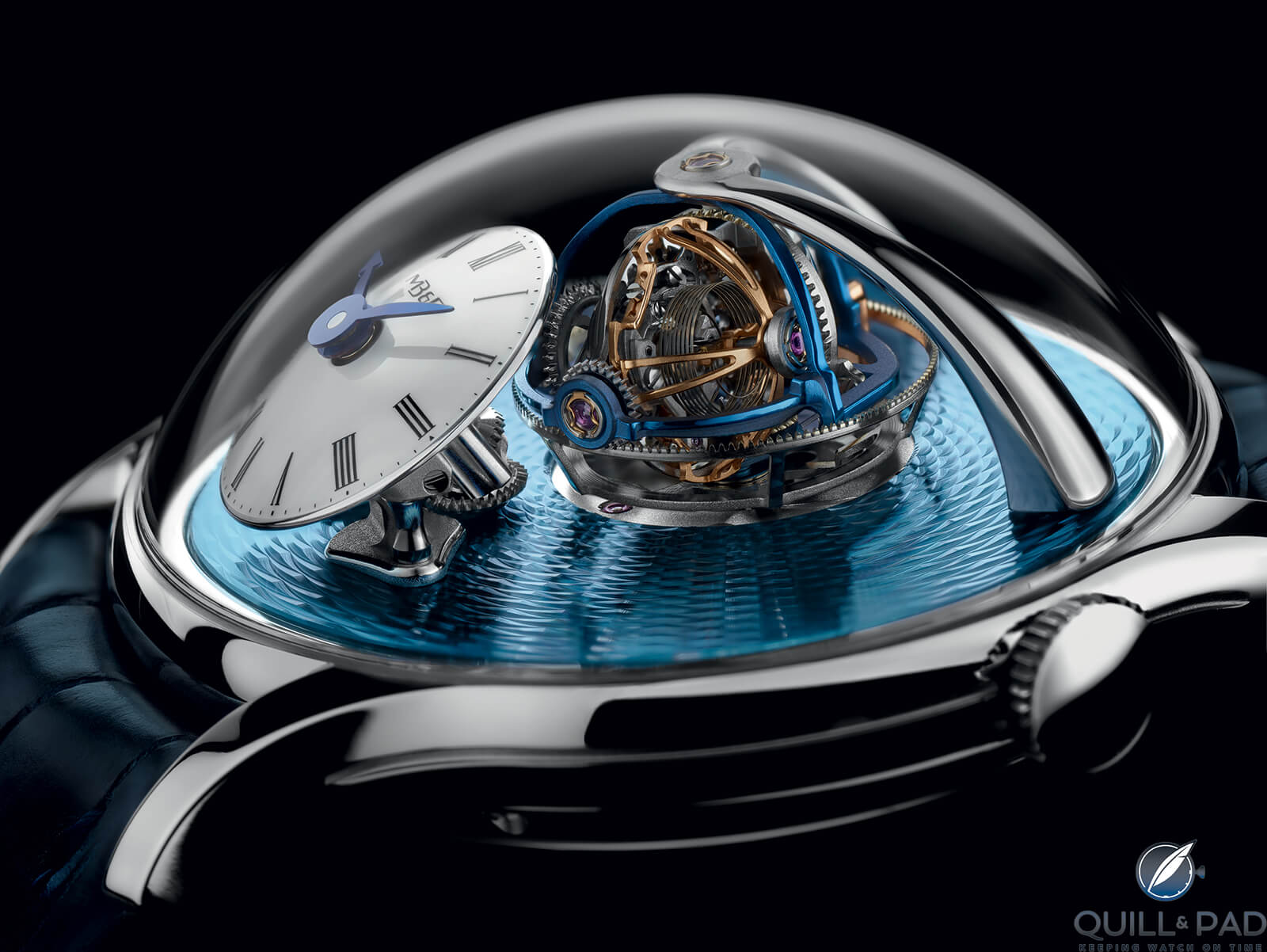
MB&F Legacy Machine Thunderdome
Legacy Machine Thunderdome is a wild combination of understated mechanical beauty and extreme horological exploration. Developed in concert with Kari Voutilainen (another watchmaking legend), the Thunderdome might seem like a continuation in theme for Coudray, but it stands alone in what it seeks to accomplish.
So sit back as we dig into the most interesting aspects of the latest superstar from MB&F and show how it strikes out on its own as the fastest triple-axis tourbillon in the world. For now.
MB&F LM Thunderdome
First off, Legacy Machine Thunderdome is a thematic follow-up to the Legacy Machine FlyingT, the first watch from MB&F designed with women in mind (or anyone else who loves it, because of course I do).
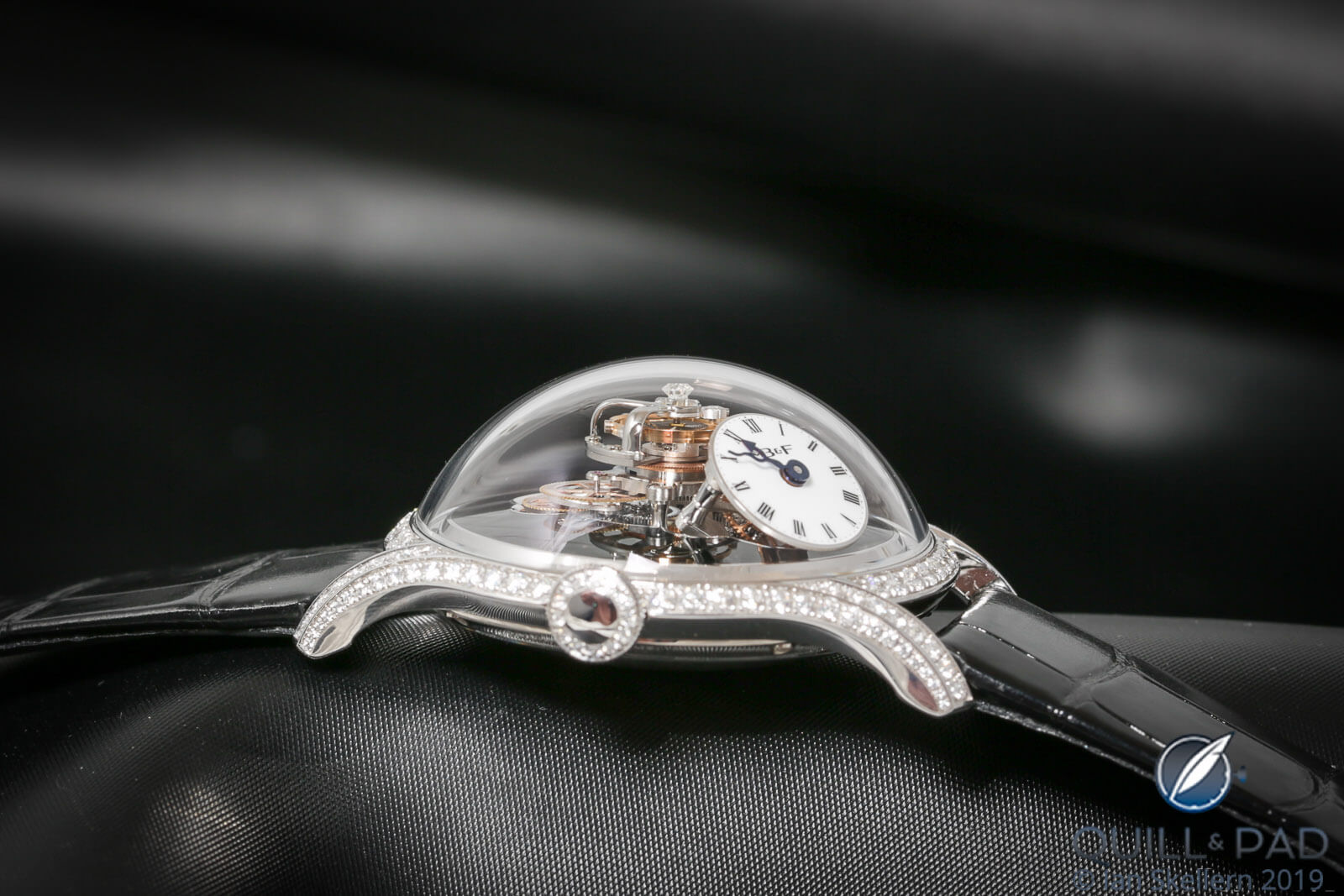
MB&F Legacy Machine FlyingT
Both watches have been in development since 2015, but MB&F assures us that it was the FlyingT, a project begun about six months before, that influenced the look and feel of the Thunderdome rather than the other way around. The two models share a lot of the same visual and structural DNA.
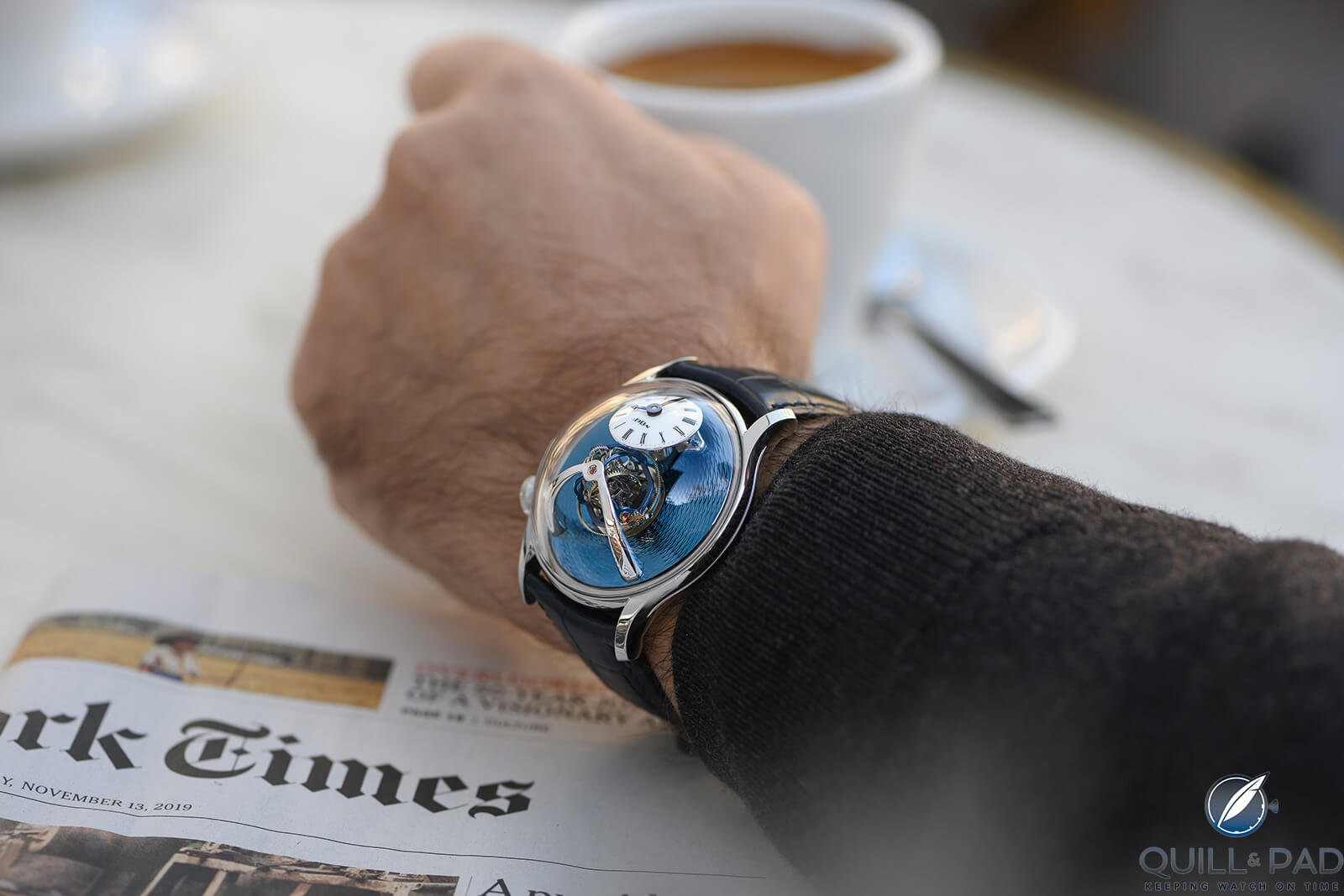
MB&F Legacy Machine Thunderdome on the wrist
The most basic description of the Thunderdome is that it is a triple-axis tourbillon suspended above the dial along with the hours-and-minutes subdial, which sits jauntily angled to the wearer at 6 o’clock.
That description probably sounds pretty cool to most watch nerds. Still, on closer inspection we see that it is no ordinary triple-axis tourbillon (because that is soooo mid to late 2000s), but a unique assembly that combines features rarely seen in watches and some that are world firsts.

MB&F Legacy Machine Thunderdome
As the fastest triple-axis tourbillon in the world, it should be noted that it rotates on three separate planes over a period of 8 seconds (center rotation), 12 seconds (center rotation), and 20 seconds (outer cage).
While this isn’t the fastest speed for a single tourbillon (that is five seconds and has been accomplished by a couple of watchmakers), when combined it is 14 seconds faster than the previous triple-axis tourbillon record holder, the C. Purnell Spherion – also developed by Coudray – with periods of 8, 16, and 30 seconds.
The TriAx (which MB&F has named its new triple-axis tourbillon) is 25 percent faster than the previous record and was designed and constructed to allow for such speeds.
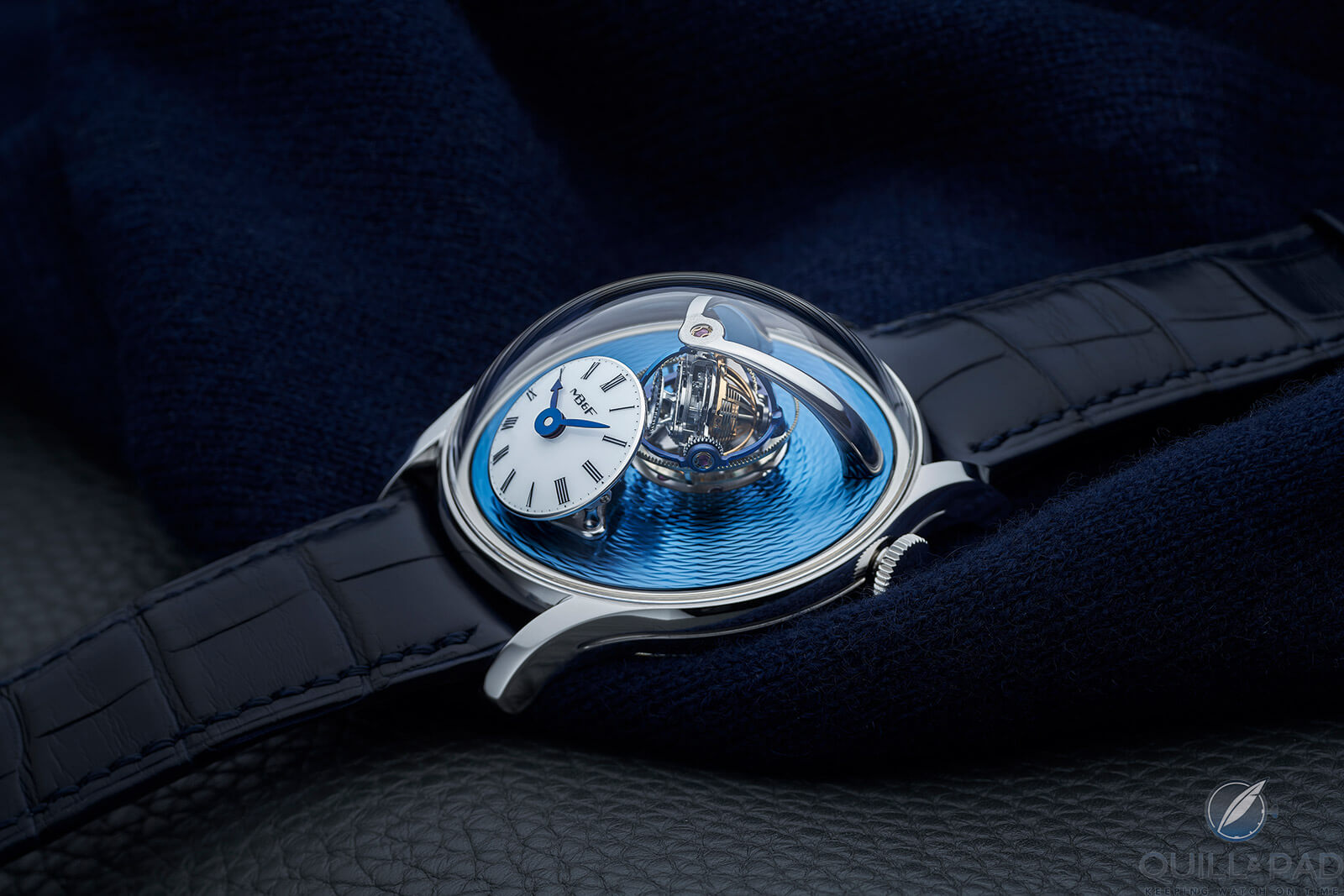
MB&F Legacy Machine Thunderdome
Combining two axes of rotation into one assembly that rotates within each other isn’t unheard of for triple-axis tourbillons (though it is not how all of them work), but the standard mechanism layout has hard limits on speed from the construction style. This is mainly due to how the rotation is translated through the escapement mechanism.
Fixed vs. rotating tourbillons
With most triple-axis tourbillons, the balance and escapement are mounted within a cage that rotates around a fixed central pinion, meaning that one full rotation of the escape wheel translates into only a portion of one full rotation for the cage based on the gear ratio.
Due to space requirements, this results in an escape wheel and pinion that differ in size with the fixed pinion almost always having significantly more teeth than the pinion affixed to the escape wheel.

MB&F Legacy Machine Thunderdome
The fastest possible configuration with this design would be two wheels with the same number of teeth so that one rotation of the escape wheel translates into one rotation of the cage.
Such a goal is hard to hit with proper gear spacing so speed limits are more conservative. The Cabestan Triple Axis Tourbillon, developed by Coudray and released in 2015, hits the upper limit of this assembly method with a central rotation period of 17 seconds.
Thus, to improve speed the ratio needed to approach 1:1, or a completely different method, would have to be employed. For this, Coudray dug deep into horological history and called upon a design from nineteenth-century watchmaker Albert H. Potter.
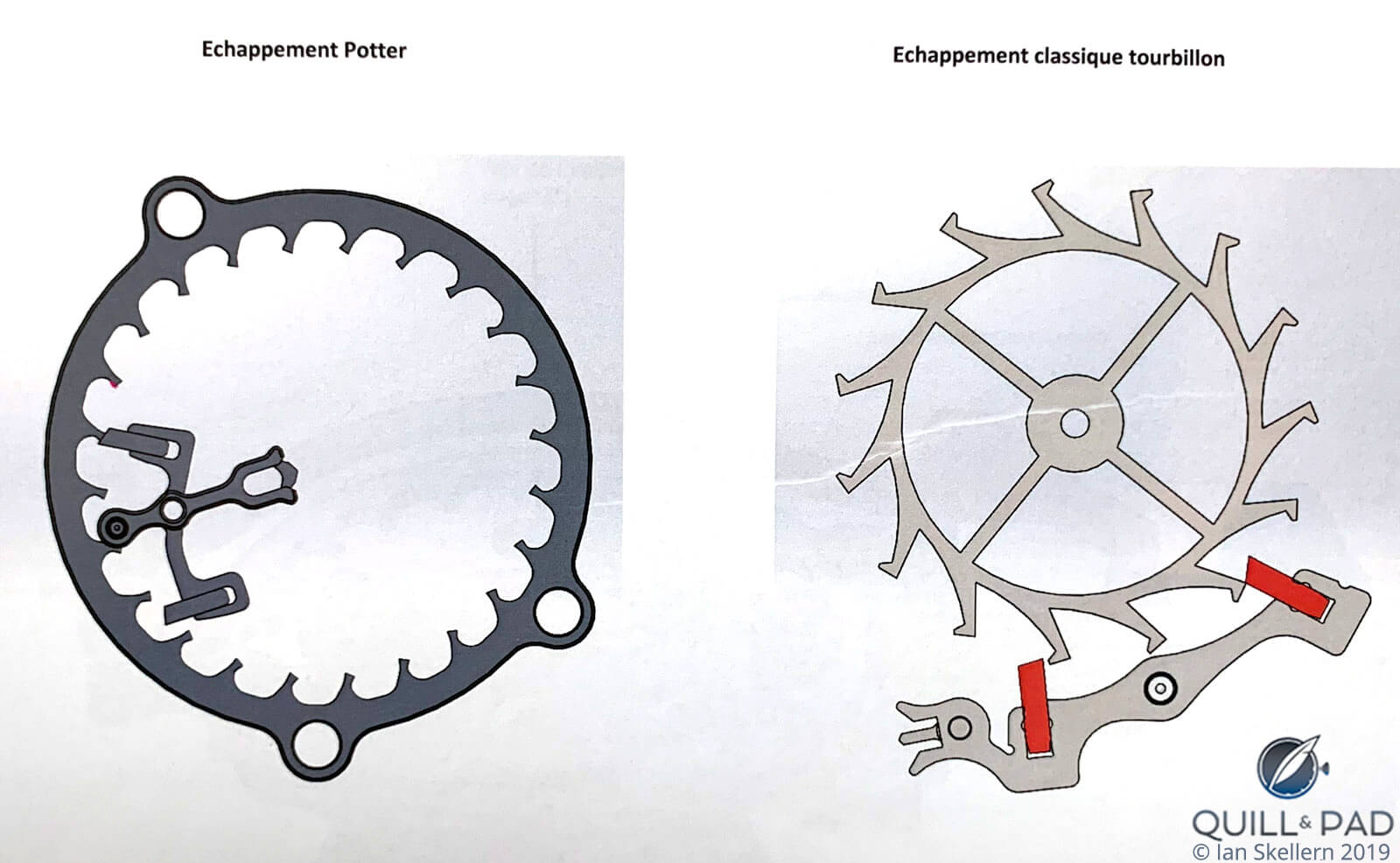
Internal escape wheel (left) of the MB&F Legacy Machine Thunderdome compared to a traditional Swiss lever escapement
This design sees the escape wheel become both fixed and an internal ring gear. The escapement lever and balance then rotate around the inside of the escape ring gear leading to a full rotation of the cage with every full pass around the ring gear.
Thanks to how gear ratios work, this escape ring gear can be a bit larger and have more teeth yet have a shorter period because the output isn’t doubling or tripling by adding a pinion that will require two or three revolutions of an escape wheel for one cage rotation.
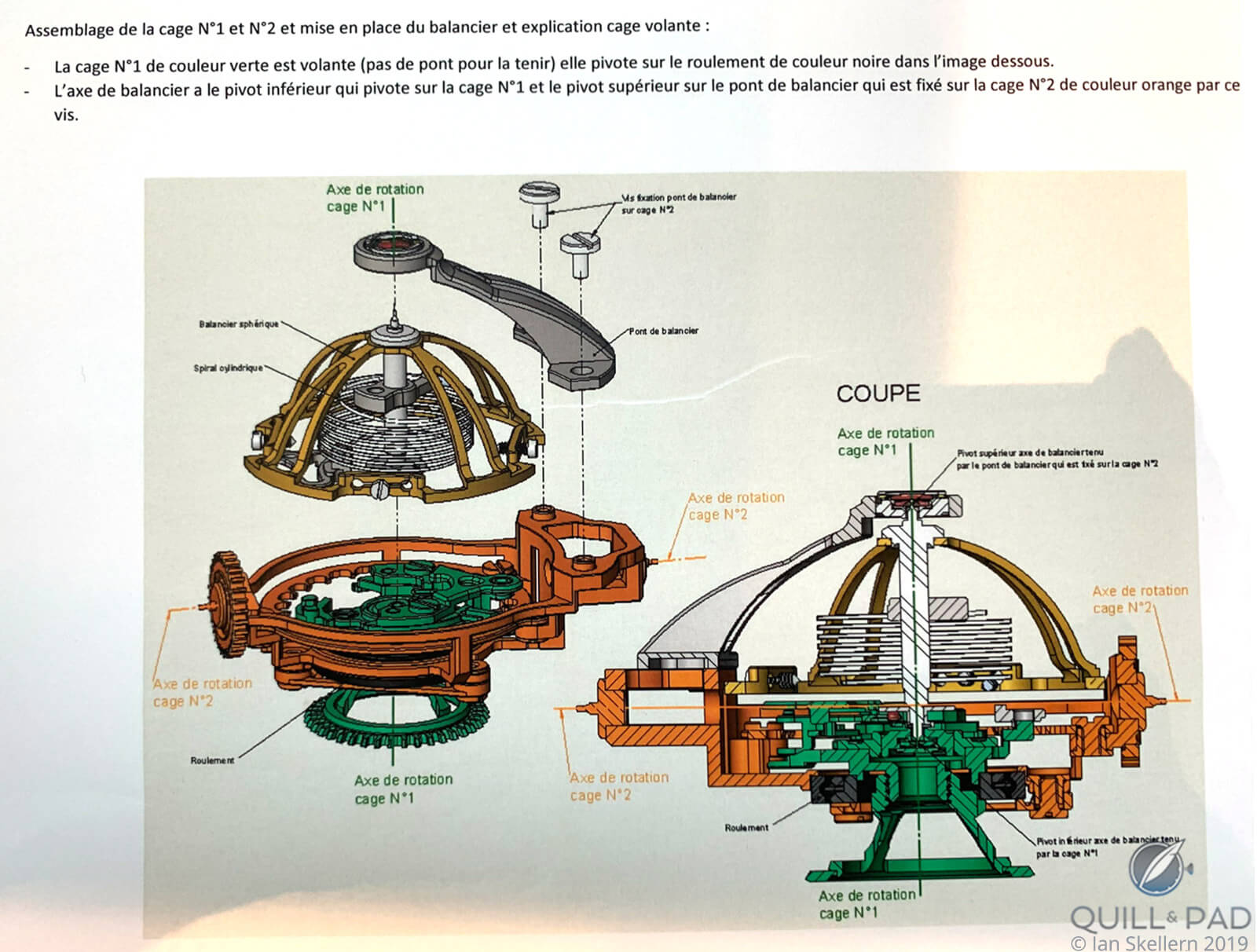
Technical diagram of the triple-axis tourbillon of the MB&F LM Thunderdome
That is how Coudray was able to go from 17 seconds for the central rotation in the Cabestan to 8 seconds for the C. Purnell Spherion, whose development began in 2015 (right after the Cabestan debuted).
Since the MB&F Thunderdome also began development in 2015, it seems clear that Coudray knew the idea could be developed in a variety of ways, and the call to work with MB&F gave him a chance to try a couple different construction methods.
1 makes 2 makes 3
The C. Purnell Spherion launched in 2017, giving Coudray the title of world’s fastest triple-axis tourbillon for the second time and I’m guessing helped demonstrate the advantages of different configurations for the three axes of rotation. The MB&F Thunderdome offered the opportunity to go for a third title.
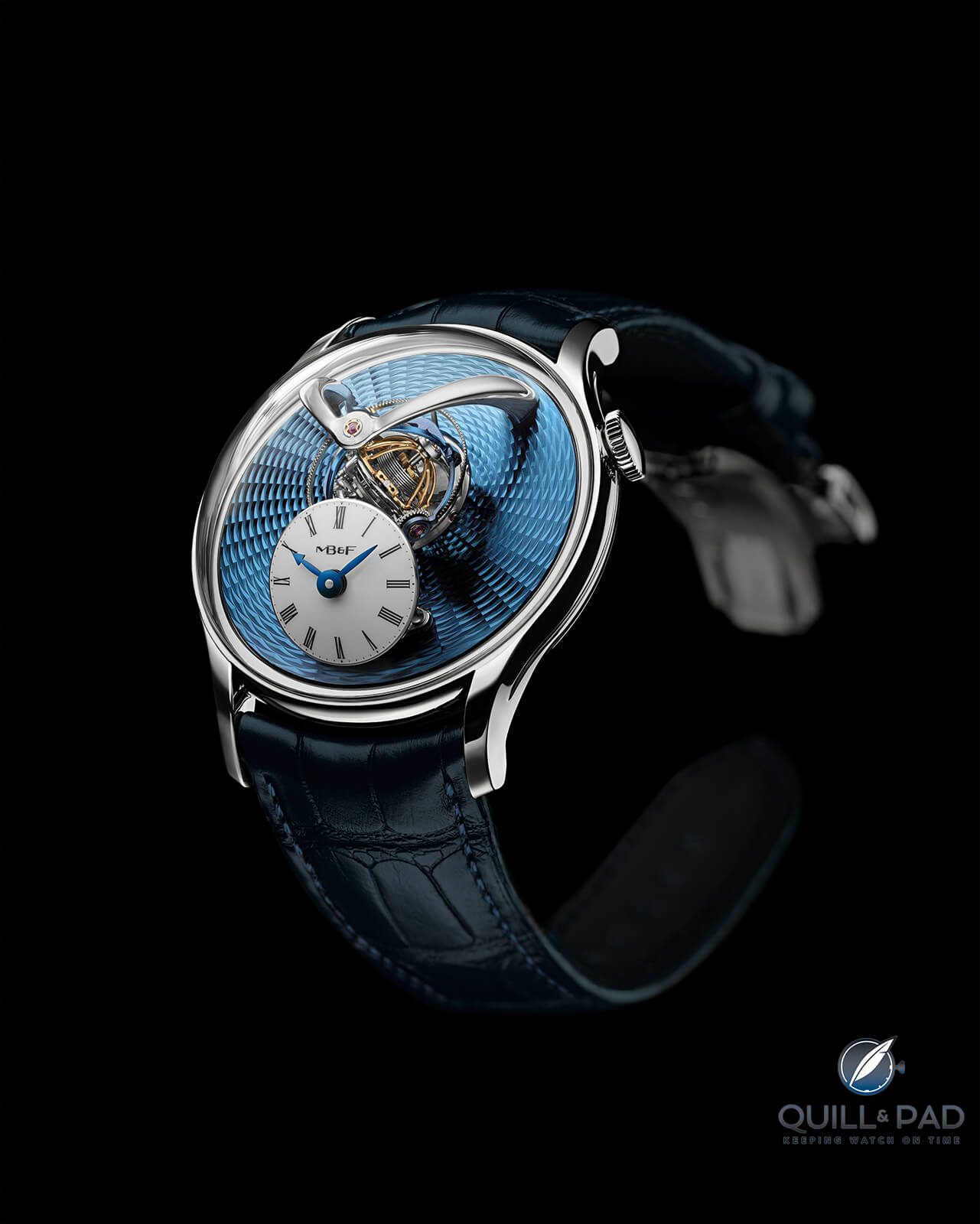
MB&F Legacy Machine Thunderdome
The Spherion and the MB&F TriAx are similar in escapement style, but fairly different when it comes to cage construction. The sizes of the intermediate wheels are driven by the way one designs the rotation of the three axes. Small adjustments to cage sizes and how they nest in each other directly limit the maximum and minimum size of the wheels and, in turn, the gear ratios.
The Spherion and the TriAx both utilize a balance oscillating at 3 Hz and have an escape ring gear of the same tooth count, which is why the central axis for both rotates in 8 seconds.
But the Spherion has a rotational period for the second axis of 16 seconds, meaning that the gear ratio it employs is 1:2. Since the TriAx in the Thunderdome completes the same rotation in 12 seconds, the gear ratio it uses is 2:3.
The only modification needed to achieve a higher ratio and the change in speed is two wheels and cage spacing.
The same type of adjustment can also be made to the outer cage to speed it up.
The Spherion’s outer cage period is 30 seconds for a gear ratio of 3.2:6 (definitely speedy for a triple-axis tourbillon), but the TriAx beats that by a third with a period of 20 seconds!
That makes a gear ratio of 3:5, clearly a small change over the Spherion gearing but when combined with all three axes it makes it the fastest by a wide margin.
This also shows how the TriAx is fundamentally a continuation of design thought for Coudray in regards to a triple-axis tourbillon, but other features make it a serious departure from horological basics. You only need look to the construction of the cage, the shape of the hairspring, and the incredible balance to understand why.
Rarity and innovation
First, thanks to the visual language that the Legacy Machine series began, the TriAx isn’t sitting in a hole in the movement or dangling off the edge. No, it is proudly suspended above the movement (or at least it appears to be).
This allows the mechanism to fully encapsulate the ideology of MB&F, which is to be a mechanical sculpture that happens to tell the time. MB&F founder Max Büsser even said the main direction he gave to Coudray was that he wanted the “craziest, most insane 3D kinetic sculpture regulator that you’ve ever done.”
I would say that Coudray took that and ran with it. The cages are large, according to Büsser the largest triple-axis tourbillon in world, and super light.
The entire assembly is less than one gram, or the weight of two paper clips, which is very impressive given its complexity. Yet the cages are only one highlight of the assembly.
For consistency and precision, the decision was made to use a helical hairspring as it breathes much better and was historically used for chronometers. The design is still fairly rare in modern watchmaking, making an appearance every few years on very high-end and very limited pieces due to the difficulty in producing one.
Given the three-dimensional nature of the TriAx, this is the best decision for visual impact and it goes perfectly with the biggest innovation on the TriAx: the hemispherical balance wheel.
You read that right; the balance wheel is not flat but a hemisphere, made into a cage that mirrors shapes seen on other triple-axis tourbillons but now is the dang oscillator.
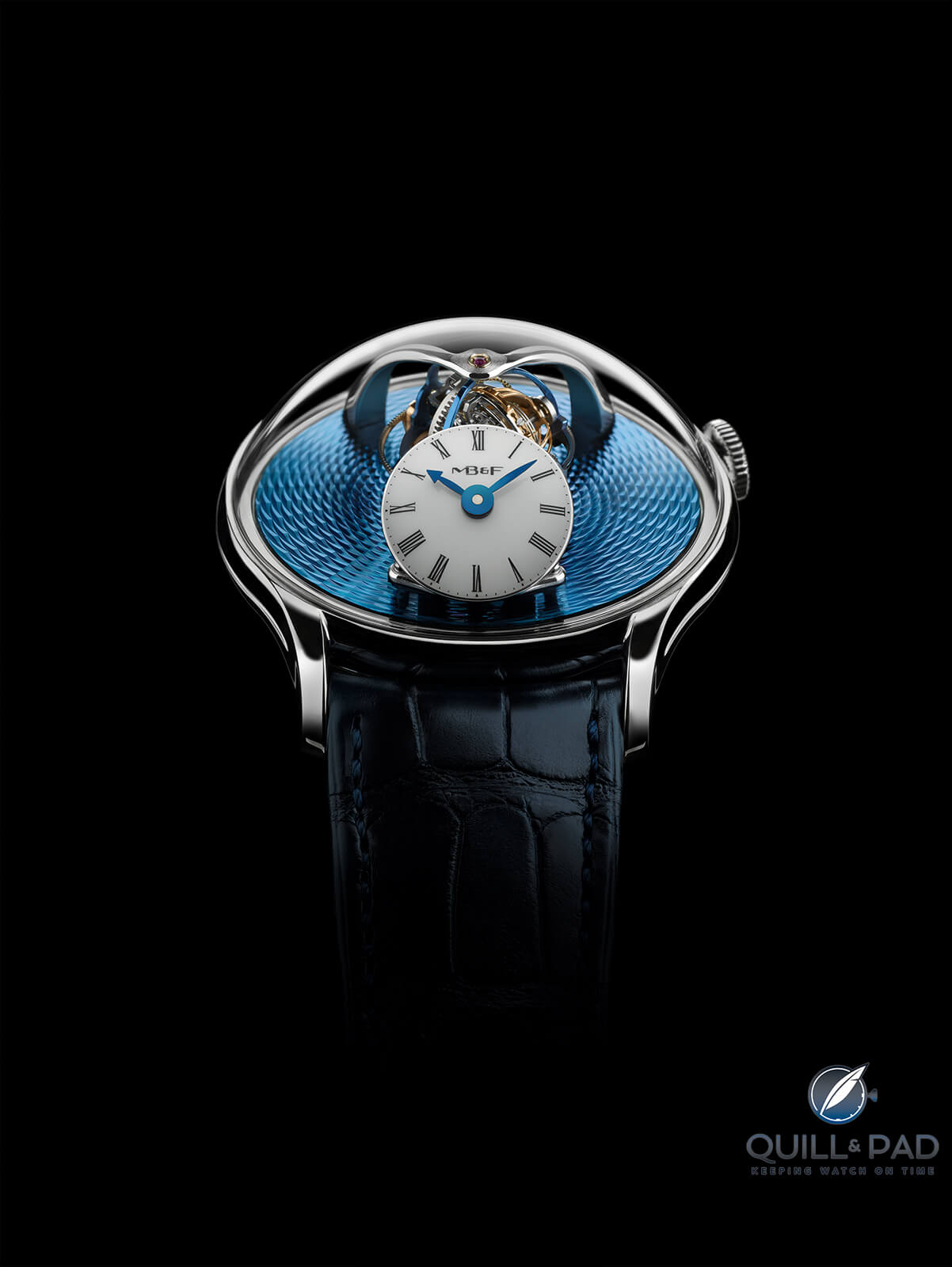
MB&F Legacy Machine Thunderdome
Anyone that has ever read up on balance wheels will know why this is such an impressive creation: making a balance wheel is notoriously difficult because it needs to be perfectly balanced (hence the name).
You can make a slight mistake in nearly every other part on a watch, but if the balance isn’t precisely balanced, the watch will not keep good time – it could even destroy itself if weighted too off-center.
So to machine a three-dimensional balance wheel would be difficult, but to adjust and form it to be as perfectly balanced as possible with the complicated shape is probably significantly harder.
The shape is complicated enough that the minutest machining errors could make it impossible to poise, meaning that every step of production and assembly must be carried out with extreme care.
As far as I know, this is the first time in modern history that any oscillator has not been a flat disk or ring.
This is probably the most impressive aspect of the TriAx in my mind, and demonstrates both MB&F and Coudray’s ability to create magic.
Half of the duo
And that magic needs to visually live up to the engineering genius, so the mechanical props of Coudray were balanced with the watchmaking mastery of Kari Voutilainen, who designed the rear of the movement in a way that befits a Legacy Machine.
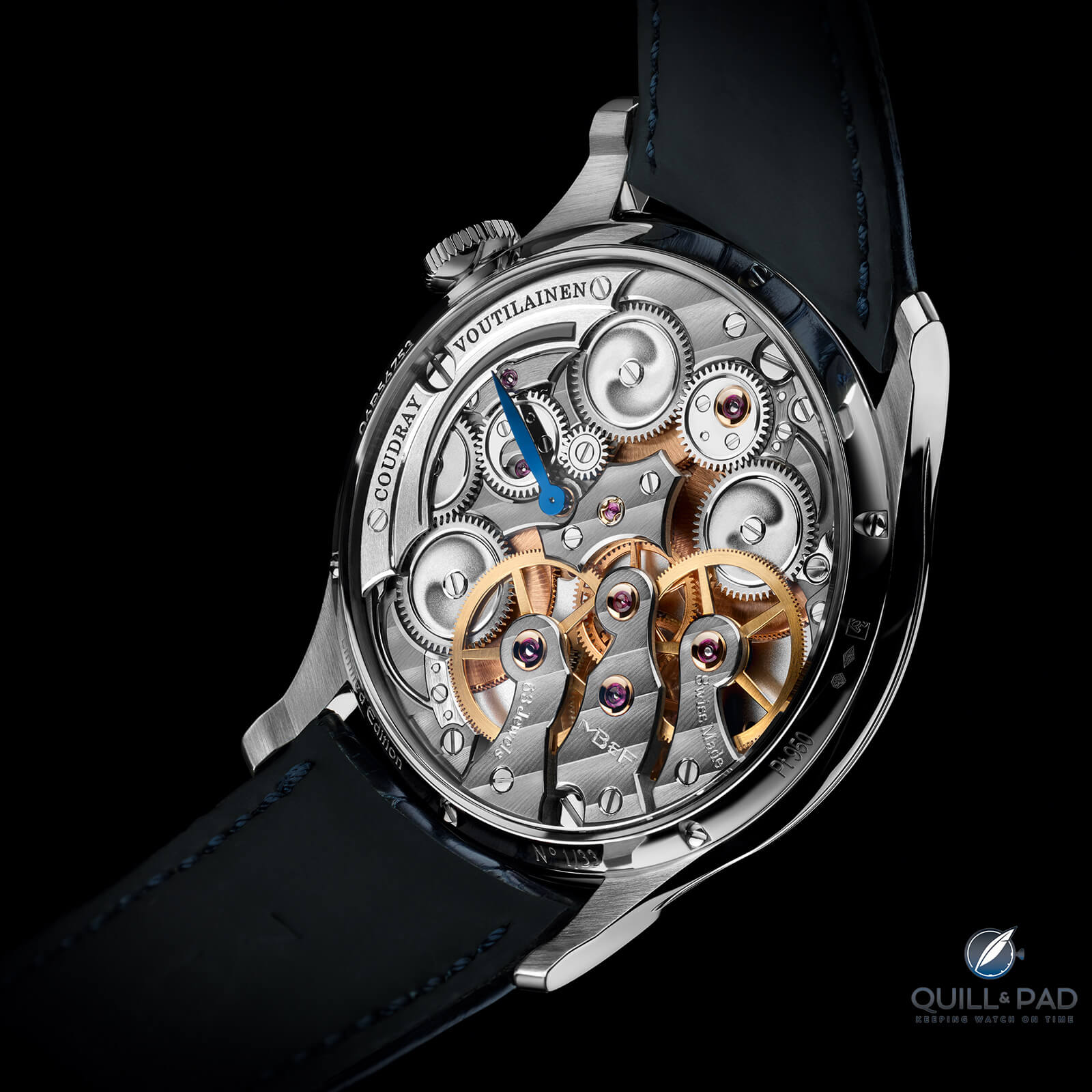
Stunning view through the large display back of the MB&F Legacy Machine Thunderdome
Having worked with MB&F since the first Legacy Machine 1, it makes sense that the most insane Legacy Machine would have its movement designed by Voutilainen. Büsser was even able to get Voutilainen to apply a proprietary finishing technique on the barrel wheels that he’s only ever applied to his own pieces.
Even more fittingly, Voutilainen decided to do the initial movement design by hand to get a more traditional layout based on his inherent understanding of proportions that can often get lost while working digitally.
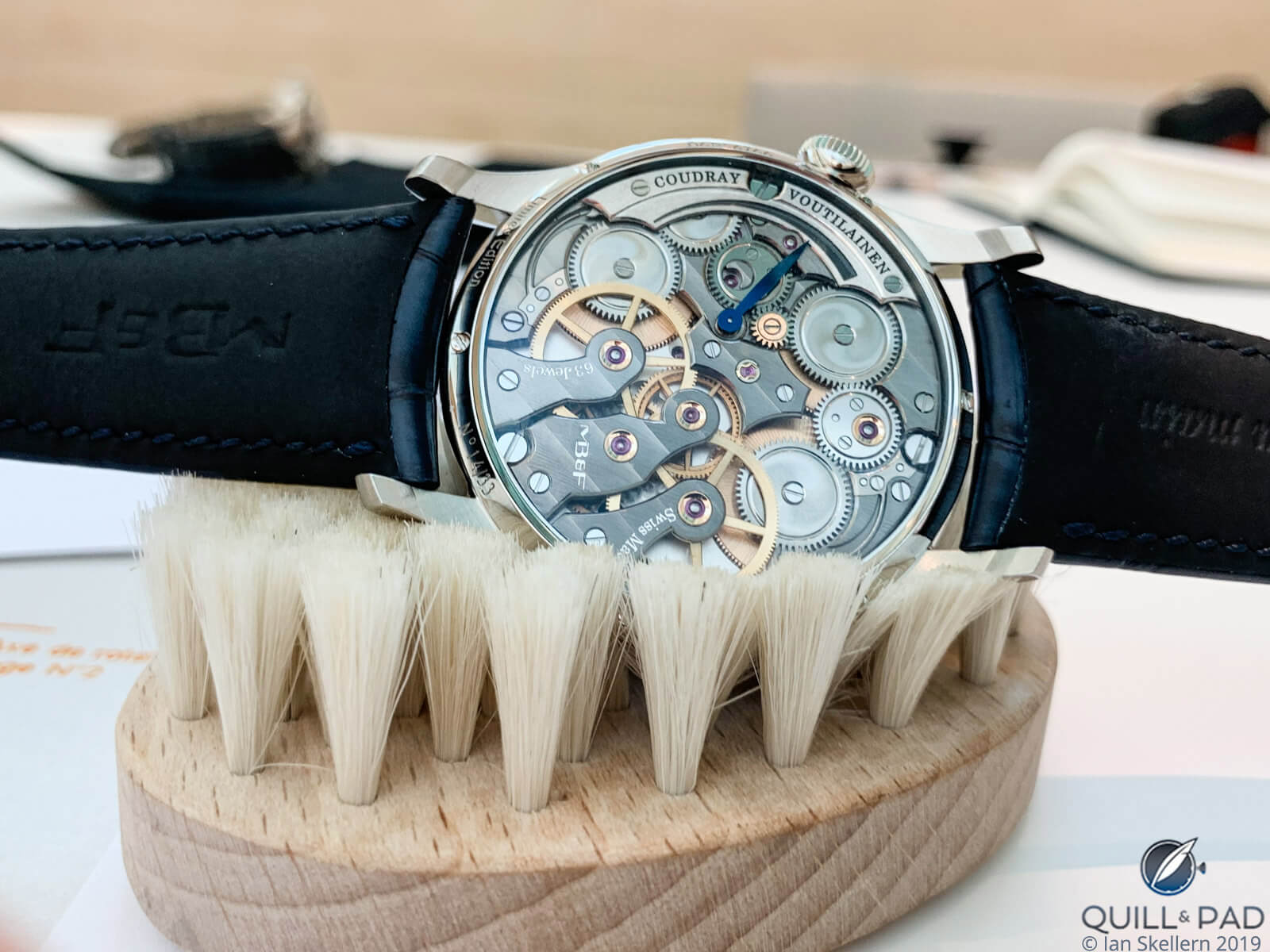
Movement of the MB&F Legacy Machine Thunderdome
There is a reason anyone who works with CAD programs has suffered from the dreaded “CAD goggles,” where things look larger or smaller because you are zoomed in on a large screen so that when produced in real life, proportions can sometimes be visually wrong.
So Voutilainen attacked the design first by hand, which clearly led to a spectacular product on the rear of the Thunderdome.
The main struggle for movement design ended up being the need to incorporate enough power to keep the TriAx moving, so three barrels were used to achieve a respectable but conservative 45 hours of power reserve.
Since long-term wear is not the point of this manual-wind watch, the power reserve indication was added to the rear of the watch, providing a great reason to regularly flip the watch over.
Usually one doesn’t have to be encouraged to flip over a Voutilainen masterpiece, but with the TriAx on the front it actually becomes a battle of awesomeness for the Thunderdome wearer.
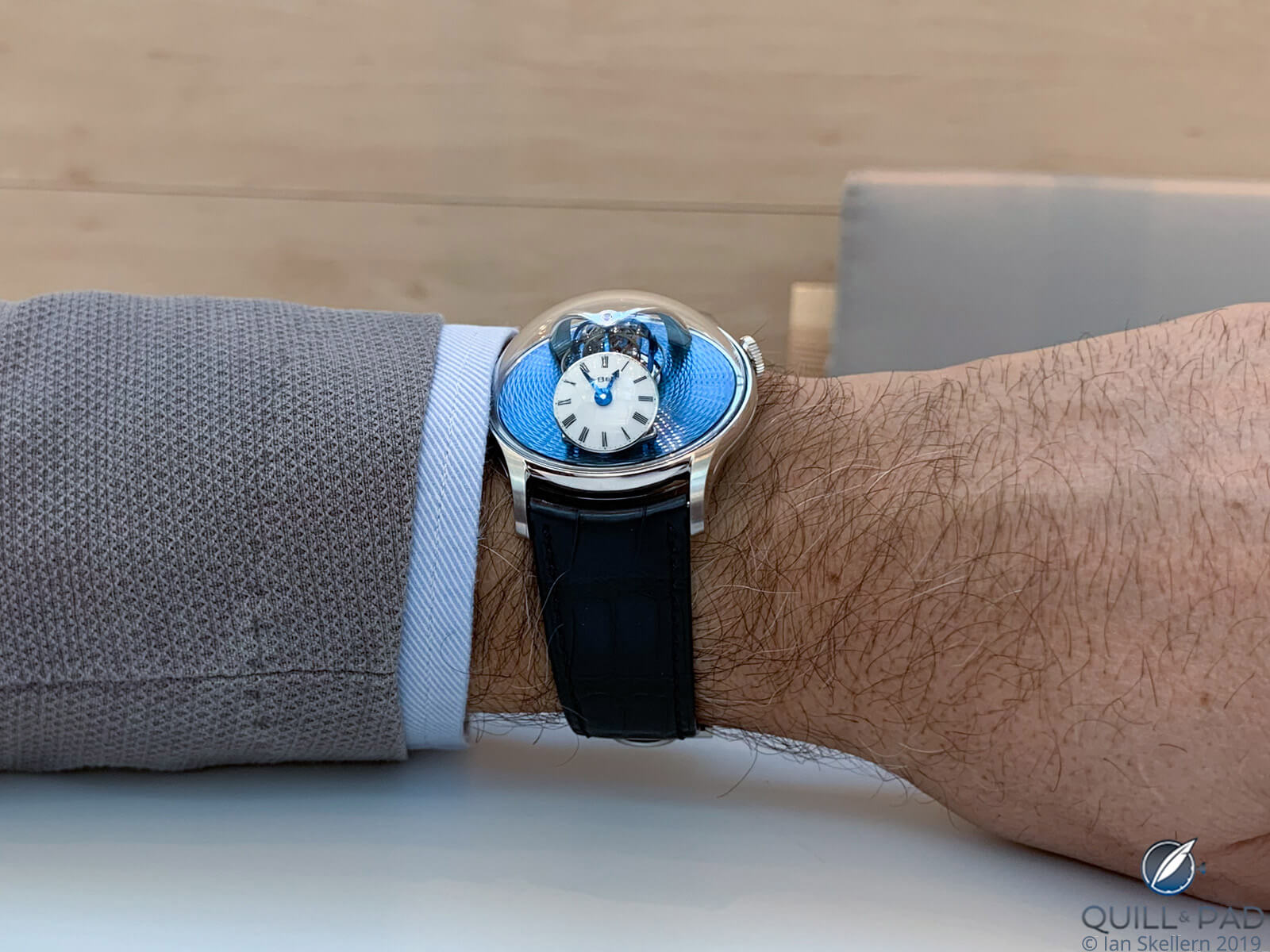
MB&F Legacy Machine Thunderdome on the wrist
The result is a package of incredible horology that is a culmination of sorts for Coudray and his quest for the fastest triple-axis tourbillon in the world. With LM Thunderdome’s release, Coudray claims the title of fastest triple-axis tourbillon for the third time in a row – and brought MB&F along for the ride.
After four years of development, the Thunderdome forms the current technical pinnacle of MB&F’s offerings. And that is saying something with its incredible catalog of creations.
Fourteen years of hard work have led to this point, and it seems clear that the future will have even more amazing machines to come.
MB&F just enjoyed a great 2019 with a win at the Grand Prix d’Horlogerie for the LM FlyingT and the launch of other outstanding projects.
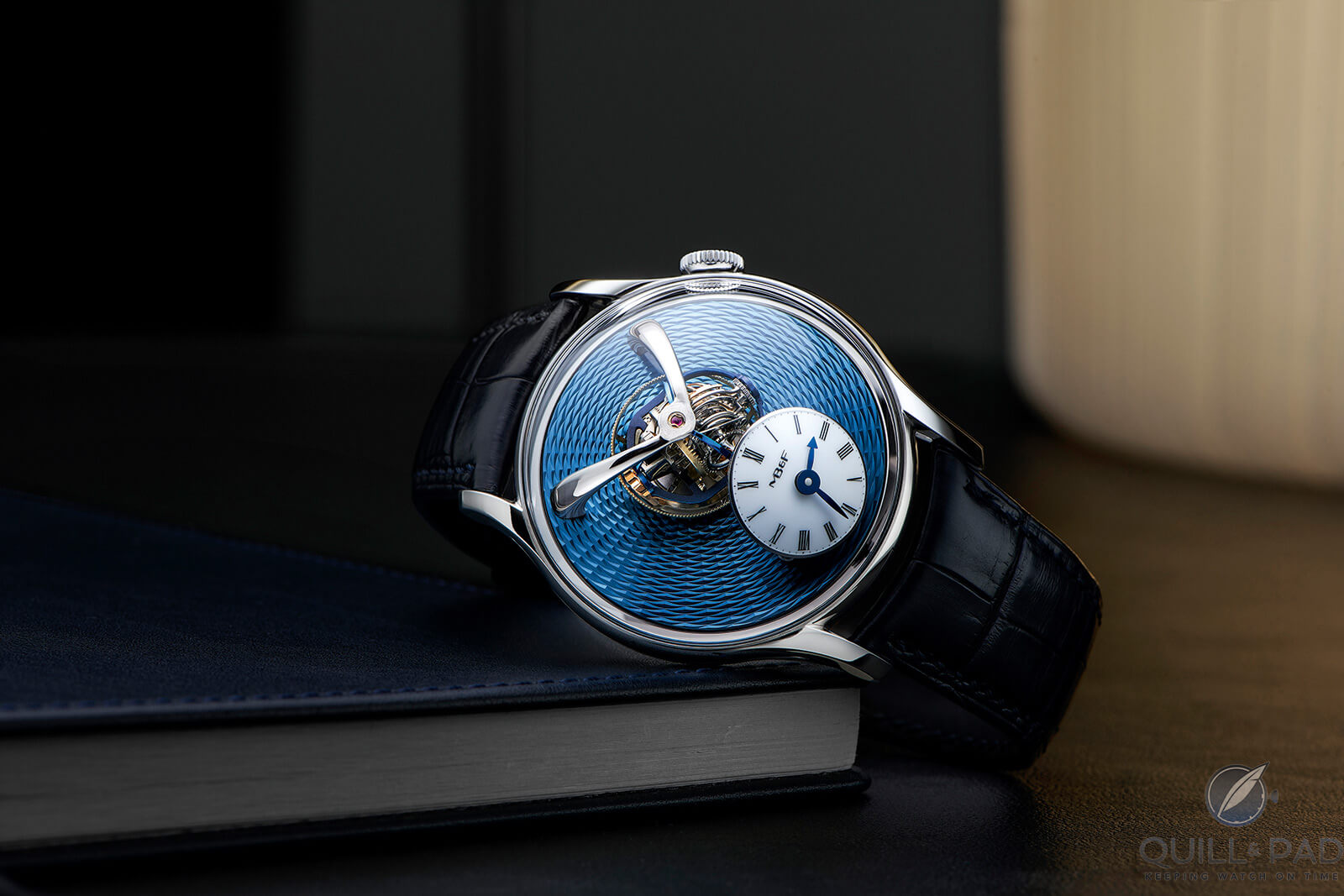
MB&F Legacy Machine Thunderdome
In a way, MB&F provided a ray of hope in a gloomy world and helped this writer retain some youthful excitement, so I’m definitely looking forward to 2020 and more from Max Büsser & Friends.
We already broke it down, but let’s break it down!
- Wowza Factor * 9.98 Nearly perfect, it only has been beaten by a couple pieces I’ve ever seen!
- Late Night Lust Appeal * 121» 1,186.604m/s2 If this thing isn’t keeping you up at night with pure lust then I might want to check your pulse because you may be dead!
- M.G.R. * 71 Seriously nothing wrong with this movement, design, or execution. It doesn’t hit a perfect score simply because for me the geekiness of some other movements tops this, but not by much!
- Added-Functionitis * Mild Power reserve! You always need a power reserve on a manual-wind watch, especially when it eats up energy like the TriAx does. Still, you’ll need children’s strength Gotta-HAVE-That cream for the whirling awesomeness!
- Ouch Outline * 12.8 The despair of knowing you can’t always get what you want, even though you really, really, want it! One of the hardest things to experience is the realization that you are fundamentally blocked from what you want simply because of the world at large. Oh well, I can always look at pictures and pester Max to let me borrow one!
- Mermaid Moment * Um, instantaneous! It took a second, well, maybe a fraction of a second to know I loved the Thunderdome. I’ll ask you: did it take you longer than that?
- Awesome Total * 1,239 Take the number of components in the movement (413) and multiply by the number of axes on the TriAx (3) for a result that is a dramatically awesome total!
For more information, please visit www.mbandf.com/en/machines/legacy-machines/lmthunderdome.
Quick Facts MB&F LM Thunderdome
Case: 44 x 22.2 mm, platinum or tantalum
Movement: manually wound Thunderdome caliber with TriAx triple-axis tourbillon revolving at 8, 12 and 20 seconds; triple spring barrels, 45-hour power reserve, 3 Hz/21,600 vph frequency, 413 components
Functions: hours, minutes; power reserve
Limitation: 33 pieces in platinum with light blue guilloche dial; 10 pieces in tantalum for The Hour Glass, 5 with aventurine dial and 5 with dark blue guilloche dial
Price: CHF 270,000
You may also enjoy:
MB&F Legacy Machine FlyingT: A Sensational Ladies Watch Both Technically And Visually Scintillating
MB&F Horological Machine N°6 Final Edition: The Last HM6, But Not The Best
MB&F MoonMachine 2 And The Proverbial Wolf Moon
MB&F’s Horological Machine 6 Alien Nation: Space Invaders Aren‘t Coming, They’re Already Here!
The Magic Is In What You Don’t See: MB&F Destination Moon Clock With L’Epée 1839
Leave a Reply
Want to join the discussion?Feel free to contribute!



Thanks for the detailed article. I’m slightly confused by what the regulating mechanism actually is since MB&F describe it as the fastest triple axis regulating mechanism in the world and another media outlet wrote that a double axis tourbillon is rotating on a karussel platform rather than it being a triple axis tourbillon. Cheers